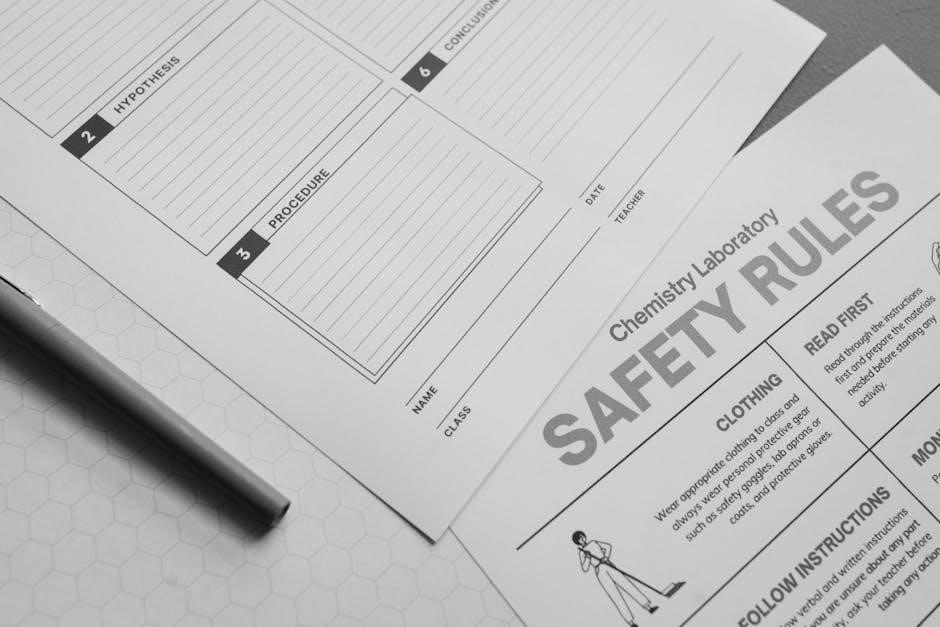Safer’s BTK Insecticide is a biological pesticide containing Bacillus thuringiensis kurstaki, effectively controlling caterpillars like cabbage worms and tomato hornworms. It’s eco-friendly, safe for plants, humans, and pets, and ideal for organic gardening. This natural solution is easy to mix and apply, making it a popular choice for sustainable pest management in gardens and landscapes.
1.1 What is Safer’s BTK Insecticide?
Safer’s BTK Insecticide is a biological pesticide containing Bacillus thuringiensis kurstaki, a naturally occurring bacterium. It specifically targets and controls caterpillars, such as cabbage worms, tomato hornworms, and tent caterpillars. This eco-friendly solution is safe for humans, pets, and beneficial insects. The product is typically sold as a liquid concentrate, which is mixed with water and applied as a foliar spray. It’s widely used on vegetables, fruits, trees, and ornamental plants to protect them from leaf-eating pests while promoting sustainable gardening practices.
1.2 Importance of Using BTK Insecticide
Using Safer’s BTK Insecticide is crucial for effectively managing caterpillar infestations while maintaining environmental safety. It’s a biological pesticide that targets specific pests without harming beneficial insects, making it ideal for organic gardening. BTK is non-toxic to humans, pets, and wildlife, reducing health risks. Its targeted action ensures that natural ecosystems remain balanced. Additionally, it decomposes quickly, leaving no harmful residues. This makes it a sustainable and responsible choice for protecting plants from damaging pests like cabbage worms and tomato hornworms.
Active Ingredients and Mode of Action
The active ingredient in Safer’s BTK Insecticide is Bacillus thuringiensis kurstaki, a bacterium producing toxins that specifically target caterpillars, disrupting their digestive system upon ingestion.
2.1 Bacillus Thuringiensis Kurstaki (BTK)
Bacillus thuringiensis kurstaki (BTK) is a naturally occurring bacterium found in soil; It produces proteins toxic to caterpillars, making it a highly effective biological pesticide. BTK is safe for plants, humans, pets, and beneficial insects, making it an eco-friendly option for gardeners. This bacterium specifically targets leaf-eating pests, ensuring targeted pest control without harming the environment. Its popularity stems from its ability to integrate seamlessly into organic gardening practices, providing a sustainable solution for managing caterpillar infestations effectively.
2.2 How BTK Works as a Stomach Poison
BTK functions as a stomach poison, requiring ingestion by caterpillars to be effective. Once consumed, the bacterium releases toxins that damage the caterpillar’s digestive system, leading to paralysis and death within 2-5 days. This targeted action ensures that only pests feeding on treated plants are affected, while beneficial insects remain unharmed. The specificity of BTK makes it a safe and environmentally friendly option for controlling leaf-eating pests without disrupting ecosystems or posing risks to non-target species.

Target Pests and Usage
Safer’s BTK Insecticide effectively controls caterpillars, including cabbage worms, tomato hornworms, tent caterpillars, gypsy moths, and leafrollers. It is suitable for use on vegetables, fruits, trees, and ornamentals.
3.1 Caterpillars Controlled by BTK
Safer’s BTK Insecticide is highly effective against various caterpillar species, including cabbage worms, tomato hornworms, tent caterpillars, gypsy moths, and leafrollers. These pests can cause significant damage to plants by feeding on leaves and fruits. BTK works as a stomach poison, requiring caterpillars to ingest the treated foliage. Once ingested, feeding stops immediately, and death occurs within 2-5 days. This targeted approach ensures control of harmful caterpillars while maintaining safety for beneficial insects and the environment.
3.2 Suitable Plants for Application
Safer’s BTK Insecticide is suitable for application on a wide variety of plants, including vegetables, fruits, trees, and ornamentals. It can be used on broccoli, Brussels sprouts, cabbage, cauliflower, kale, and other leafy greens. Additionally, it is effective for protecting fruit-bearing plants like tomatoes and berries. The product is also safe for use on shade trees, evergreens, and ornamental plants, making it a versatile solution for gardeners and landscapers aiming to protect their plants from caterpillar damage while maintaining environmental safety.

Mixing Instructions
Mix 30 mL of Safer’s BTK concentrate in 10 liters of water. Shake the sprayer periodically to ensure proper mixing. Use the solution within 12 hours for optimal effectiveness.
4.1 Recommended Mix Ratio
The recommended mix ratio for Safer’s BTK Insecticide is 30 mL of concentrate in 10 liters of water. This solution covers approximately 100 square meters. For severe infestations, increase the ratio up to 4 teaspoons per gallon. Always mix the concentrate with water first, then fill the sprayer to the desired volume. Shake the sprayer periodically to maintain even distribution. Use the solution within 12 hours of preparation for maximum potency. Adjust the ratio based on pest severity and plant coverage needs.
4.2 Steps to Prepare the Spray Solution
- Fully fill a handheld sprayer with water, then add the recommended amount of Safer’s BTK Insecticide concentrate.
- Continue filling the sprayer with water to the desired volume, ensuring proper dilution.
- Shake the sprayer periodically to mix the solution thoroughly and maintain even distribution.
- Use the prepared spray solution within 12 hours for optimal effectiveness.

Application Methods
Safer’s BTK Insecticide is primarily applied as a foliar spray, ensuring thorough coverage of leaf surfaces. It can also be used as a soil drench for systemic protection. Other methods include basal bark applications for tree pests, ensuring the product reaches the target area effectively for optimal pest control.
5.1 Foliar Spray Application
Safer’s BTK Insecticide is most effectively applied as a foliar spray. Mix 30 mL of concentrate in 10 liters of water, covering approximately 100 m². Shake the sprayer periodically to maintain even distribution. Apply thoroughly to all leaf surfaces, ensuring no runoff. Repeat every 7-10 days if pest pressure persists. For best results, spray when caterpillars first appear and leaf expansion reaches 40-50%. Use the solution within 12 hours of preparation for optimal potency.
5.2 Soil Drench Application
While Safer’s BTK Insecticide is primarily used as a foliar spray, it can also be applied as a soil drench for systemic action. Mix the recommended dose with water and pour around the base of plants. This method ensures the insecticide is absorbed through the roots, targeting pests like caterpillars feeding on foliage. However, this application is less common and may be less effective than foliar spraying. Always follow label instructions and avoid overuse to prevent potential harm to beneficial organisms. Store unused solution properly to maintain potency.
5.3 Other Application Methods
Besides foliar spraying, Safer’s BTK Insecticide can be applied through trunk injection for tree protection or mixed into irrigation systems for larger areas. For smaller plants, a soak method can be used by submerging foliage in the solution. Always ensure thorough coverage and avoid applying during peak sunlight to prevent leaf burn. Store any unused mixture in a sealed container and use within 12 hours for optimal potency. Shake the sprayer periodically to maintain even distribution of the active ingredient.

Usage on Specific Plants
Safer’s BTK Insecticide is versatile for use on vegetables, fruits, ornamental plants, and trees. It effectively controls caterpillars on broccoli, cabbage, tomatoes, and shade trees, ensuring plant protection and health.
6.1 Vegetables and Fruits
Safer’s BTK Insecticide is highly effective for protecting vegetables and fruits from caterpillar damage. It controls pests like cabbage worms, tomato hornworms, and leafrollers. For vegetables such as broccoli, cabbage, and kale, mix 30 mL of concentrate in 10 liters of water and spray thoroughly. For fruits, including tomatoes and berries, apply the same mix ratio to ensure coverage. The solution is safe for plants and the environment, making it ideal for organic gardening. Regular application ensures healthy growth and pest-free harvests.
6.2 Ornamental Plants and Trees
Safer’s BTK Insecticide is ideal for protecting ornamental plants and trees from caterpillar infestations. It effectively controls pests like tent caterpillars, gypsy moths, and leafrollers. For ornamental trees and shrubs, mix 30 mL of concentrate in 10 liters of water and spray thoroughly. This solution is gentle on plants and the environment, making it suitable for maintaining healthy landscapes. Regular application ensures protection against damaging pests, preserving the beauty and health of your ornamental plants and trees throughout the growing season.
6.3 Shade Trees and Evergreens
Safer’s BTK Insecticide is highly effective for protecting shade trees and evergreens from caterpillar damage. It controls pests like gypsy moths, tent caterpillars, and leafrollers without harming the trees. Mix 30 mL of concentrate in 10 liters of water and apply as a foliar spray. This eco-friendly solution ensures long-lasting protection while maintaining the health and appearance of your shade trees and evergreens, making it a reliable choice for sustainable tree care and pest management.

Safety Precautions
Wear protective gloves and eyewear when handling Safer’s BTK Insecticide. Avoid skin contact and inhalation. Store the product between 0°C and 20°C, out of reach of children and pets. The solution is safe for beneficial insects but ensure proper handling to minimize exposure. Follow all instructions carefully to maintain safety and effectiveness.
7.1 Personal Protective Equipment
When handling Safer’s BTK Insecticide, wear protective gloves and eyewear to avoid skin and eye irritation. Use long-sleeved clothing to minimize skin exposure. Ensure the product is stored in its original container, out of reach of children and pets. While the insecticide is eco-friendly and safe for beneficial insects, proper handling is essential to prevent accidental exposure. Always follow the manufacturer’s guidelines for safe application and storage to maintain effectiveness and safety for both users and the environment.
7.2 Storage and Disposal Guidelines
Store Safer’s BTK Insecticide in its original container, keeping it tightly sealed and protected from extreme temperatures (0°C to 20°C). Keep it out of reach of children and pets. Dispose of unused product and empty containers according to local regulations. Do not reuse containers for other purposes. Ensure proper storage to maintain microbial purity and potency, and use the product within two years of the manufacture date for optimal effectiveness. Proper disposal helps protect the environment and ensures safety.

Environmental Impact
Safer’s BTK Insecticide is eco-friendly, biodegradable, and non-toxic to beneficial insects, birds, and mammals. It targets specific pests, reducing environmental harm and promoting sustainable gardening practices effectively.
8.1 Eco-Friendly Nature of BTK
Bacillus thuringiensis kurstaki (BTK) is a naturally occurring bacterium, making it an eco-friendly alternative to chemical pesticides. It biodegrades quickly, reducing environmental impact. BTK specifically targets caterpillars, leaving beneficial insects like bees and butterflies unharmed. This selective action minimizes harm to non-target species, supporting biodiversity. Additionally, BTK is non-toxic to humans, pets, and wildlife, aligning with sustainable gardening practices. Its use promotes a balanced ecosystem, making it a preferred choice for environmentally conscious gardeners seeking effective yet safe pest control solutions.
8.2 Impact on Beneficial Insects
BTK is highly selective, primarily affecting caterpillars while leaving beneficial insects like bees, butterflies, and ladybugs unharmed. This specificity reduces the risk of disrupting natural pest control systems. Unlike broad-spectrum pesticides, BTK minimizes harm to non-target species, preserving biodiversity. Its targeted action ensures that pollinators and other beneficial insects remain unaffected, making it a safer choice for integrated pest management and organic gardening practices. This eco-friendly approach supports a balanced ecosystem and promotes sustainable gardening without compromising environmental health.

Effectiveness and Duration
BTK insecticide works within a few days, with caterpillars stopping feeding immediately after ingestion and dying within 2-5 days. The solution remains effective for up to 12 hours after mixing.
9.1 How Long Does BTK Take to Work?
BTK insecticide begins working immediately after ingestion by caterpillars, stopping their feeding within hours. Death typically occurs within 2-5 days, depending on the pest and dose. The solution must be used within 12 hours of mixing for optimal potency, as microbial activity decreases over time. Regular monitoring is recommended to ensure effectiveness and determine if reapplication is needed, especially in cases of high pest pressure or rapid leaf growth.
9.2 Factors Affecting Efficacy
The effectiveness of BTK insecticide depends on several factors, including proper application timing, thorough leaf coverage, and weather conditions. Rainfall or irrigation can reduce potency, necessitating reapplication. Storage temperature (0-20°C) and product freshness also impact performance. Ensuring the solution is well-mixed and applied when caterpillars are actively feeding maximizes results. Incorrect dosing or poor spray coverage can lead to reduced efficacy, allowing some pests to survive and potentially develop resistance over time.
Reapplication and Timing
Reapply Safer’s BTK every 7-10 days, especially after rain or when new caterpillars emerge. Ensure the solution is used within 12 hours of mixing for optimal effectiveness.
10.1 When to Reapply BTK
Reapply Safer’s BTK Insecticide every 7-10 days, especially after heavy rain or when new caterpillars emerge. The solution must be used within 12 hours of mixing. Since BTK is a stomach poison, caterpillars must ingest it to be effective. Feeding stops immediately after ingestion, with death occurring in 2-5 days. Repeat applications ensure continuous control of newly hatched caterpillars. For best results, apply when caterpillars are young and actively feeding. Proper timing and coverage are crucial for maximizing effectiveness.
10.2 Optimal Timing for Application
Apply Safer’s BTK Insecticide when caterpillars are first spotted and during early leaf expansion (40-50%). Spray in the early morning or late afternoon to avoid direct sunlight, which can degrade the product. Ensure thorough coverage of all leaf surfaces for maximum effectiveness. The solution must be used within 12 hours of mixing. Timing applications when caterpillars are actively feeding ensures better ingestion of the toxin, leading to faster results. Consistent and well-timed applications are key to achieving optimal pest control and protecting your plants from damage.
Mixing Tips and Tricks
For optimal results, mix 30 mL of Safer’s BTK with 10 liters of water. This solution covers approximately 100 square meters. Always use the mixture within 12 hours for best efficacy.
11.1 Ensuring Proper Mixing
To ensure proper mixing, start by adding water to your sprayer before introducing Safer’s BTK. Mix 30 mL of concentrate with 10 liters of water, stirring well. Shake the sprayer periodically to maintain even distribution. Avoid storing the mixed solution, as potency decreases over time. Use the mixture within 12 hours for optimal effectiveness. Proper mixing ensures the insecticide adheres evenly to leaf surfaces, maximizing its impact on target pests like caterpillars.
11.2 Maintaining Solution Potency
To maintain the potency of Safer’s BTK solution, use the mixed formula within 12 hours of preparation. Store the concentrate in its original container between 0°C and 20°C to preserve microbial activity. Avoid exposing the solution to direct sunlight or extreme temperatures, as this can reduce effectiveness. Always mix the recommended amount to ensure optimal performance. Proper storage and handling will help retain the product’s potency for up to 2 years from the manufacture date, ensuring reliable pest control when needed.
Common Mistakes to Avoid
- Not shaking the sprayer periodically, reducing product effectiveness.
- Using incorrect mix ratios, leading to under or over-application.
- Applying BTK in direct sunlight, which can degrade the solution.
- Not reapplying as needed, allowing pest populations to rebound.
12.1 Overuse or Underuse of Product
Overusing Safer’s BTK Insecticide can harm beneficial insects and the environment, while underuse may fail to control pest populations effectively. Always follow the recommended mix ratio of 30 mL in 10 liters of water and apply as directed. Using more than specified can lead to residue buildup, while using less may not adequately protect plants. Ensure the solution is used within 12 hours of preparation for optimal potency. Proper dosage maintains efficacy and environmental safety, avoiding unnecessary chemical overload in your garden ecosystem.
12.2 Improper Application Techniques
Improper application of Safer’s BTK Insecticide, such as not shaking the sprayer periodically, can lead to uneven distribution and reduced efficacy. Applying the product when caterpillars are too large or not covering all leaf surfaces thoroughly may result in poor control. Using the solution beyond the recommended 12-hour window or applying it in direct sunlight can also decrease potency. Ensure thorough coverage and apply when caterpillars are small for best results, as improper techniques can compromise pest control effectiveness and waste product.

Troubleshooting
Common issues with Safer’s BTK include low efficacy due to improper mixing or application. Ensure thorough leaf coverage and reapply as needed to prevent pest resistance and maintain effectiveness.
13.1 Low Efficacy of BTK
Low efficacy of Safer’s BTK often results from improper application or mixing. Ensure the solution is well-shaken and applied thoroughly to all leaf surfaces. Avoid spraying during intense sunlight or rain, as this reduces potency. Check the product’s expiration date and storage conditions, as degraded BTK may lose effectiveness. Reapplication within 7-10 days is recommended for optimal results. Always follow the recommended mix ratio to maintain potency and effectiveness against target pests.
13.2 Managing Pest Resistance
To prevent pest resistance, rotate BTK with other control methods and ensure proper application. Apply the recommended dosage and avoid overuse, as this can lead to resistant pest populations. Monitor pest activity and reapply only when necessary. Maintain good garden hygiene and promote beneficial insects to balance ecosystem health. By using BTK judiciously, you can sustain its effectiveness and protect your plants from developing resistance to this eco-friendly solution.

Advantages Over Chemical Pesticides
Safer’s BTK Insecticide is eco-friendly, non-toxic to humans, pets, and beneficial insects, and aligns with organic gardening practices, making it a safer alternative to chemical pesticides.
14.1 Safety for Humans and Pets
Safer’s BTK Insecticide is non-toxic to humans, pets, and beneficial insects, making it a safe choice for gardens and landscapes. Derived from natural bacteria, it poses no harm to people or animals when used as directed. Proper storage in the original container, away from children and pets, ensures safety. This eco-friendly solution aligns with organic practices, providing peace of mind for gardeners prioritizing health and sustainability.
14.2 Compatibility with Organic Gardening
Safer’s BTK Insecticide is OMRI-listed, making it fully compatible with organic gardening practices. This biological pesticide contains no synthetic chemicals, aligning with organic standards. It targets only caterpillars, leaving beneficial insects unharmed. Its natural, biodegradable formula ensures minimal environmental impact, promoting sustainable gardening. Gardeners can confidently use it on vegetables, fruits, and ornamentals without compromising their commitment to organic growing methods. This eco-friendly solution supports biodiversity and maintains soil health, making it a preferred choice for organic enthusiasts.
Safer’s BTK Insecticide is a reliable, eco-friendly solution for controlling caterpillars, safe for organic gardening and the environment. Use as directed for optimal results.
15.1 Summary of Key Points
Safer’s BTK Insecticide is a biological pesticide containing Bacillus thuringiensis kurstaki, targeting caterpillars like cabbage worms and tomato hornworms. It’s applied as a foliar spray, mixed with water, and works as a stomach poison, stopping feeding within hours and killing pests in 2-5 days. Safe for humans, pets, and plants, it’s ideal for organic gardening. Store between 0°C and 20°C and use within two years for optimal effectiveness. Follow instructions for proper mixing and application to ensure best results.
15.2 Final Tips for Effective Use
For optimal results with Safer’s BTK Insecticide, mix 30 mL in 10 liters of water and shake the sprayer periodically. Apply as a foliar spray, ensuring thorough coverage of leaf surfaces. Repeat every 7-10 days if needed. Use when caterpillars first appear and during early leaf expansion (40-50%). Store the product between 0°C and 20°C to maintain potency. Always follow instructions for mixing and application to ensure safety and effectiveness. This eco-friendly solution promotes sustainable gardening while protecting your plants from damaging pests.
